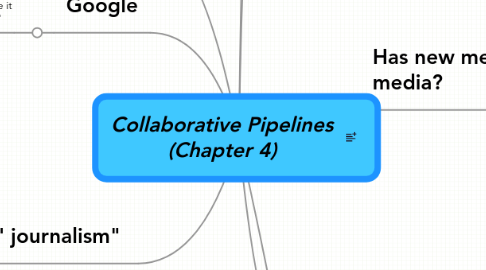
1. "Citizens' journalism"
1.1. Citizen-generated content reduces costs or costs = zero.
1.2. Anyone can start a blog, bulletin board, or chat room.
1.2.1. Focus can be on small communities, making amateur journalists "content shepherds"
1.3. Citizens play active role in content creation
1.3.1. This participation is wholly democratic.
2. Google
2.1. Mission statement: "To organize the world's information and make it universally accessible and useful"
2.1.1. Is this really the common independent public sphere?
2.1.2. How can we know it is unselfishly serving democracy?
2.1.3. Google chooses what information is deemed "useful." By what standards?
3. Clash of Culture and Commerce
3.1. The market economy is facing a rival economic system; network relationships.
3.1.1. Software
3.1.2. Telecommunications
3.1.3. Internet
3.2. Shift from a propertied regime to access regime
3.3. Shift from industrial production to cultural production
3.3.1. Consequence: Our lives become exploited
3.3.1.1. User generated content (UGC)
3.3.1.1.1. We are all "experts" and content producers
4. Telecom
4.1. The "democratization of local TV"
5. The Age of Access!
5.1. "Normative power of the factual"
5.1.1. Technology Shapes Content
5.1.1.1. Rise of two way media and the ability to communicate anytime, anyplace.
5.1.1.1.1. Information and Communication Technology (ICT)
5.1.1.1.2. Open Source and free software
5.1.1.2. But technology does not necessarily lead to the democratization of information
5.1.1.2.1. "Command/control = increased social homogenization
5.1.1.3. Rise of global media empires (ex: Newscorp)
6. Feedback and Interaction
6.1. Interactive t.v. projects
6.1.1. Germany's 9-Live
6.1.2. Van Gogh TV
6.1.3. "Piazza virtuale"
6.2. "Every receiver is a transmitter"
7. Participatory Media
7.1. Current TV (www.current.tv)
7.1.1. Create a "pipeline of your production"
7.1.2. Al Gore is chairman
7.1.2.1. Aims to recruit a gorilla army of activists.
7.2. The media is the message!
7.2.1. Media consumers are becoming more involved in creating, editing, and re-purposing content
7.2.1.1. "Don't hate the media, be the media" -IBM
7.3. Wikis and podcasts
7.3.1. Benefit: Everyone can produce content
7.3.2. Downside: Too much information to sift through; What is accurate?
7.4. Citizen journalism is even becoming part of commercial media production
7.4.1. CNN and ireports are examples of media companies using amateur reporting tools
7.4.1.1. Commercial media can also exploit amateur media outlets.
8. Has new media replaced old media?
8.1. Shift is to digital media
8.2. Newspapers are experiencing decreased circulation
8.3. Established media may not completely die; a combined media will be the future
8.3.1. Constant change and development; there will no longer be a dominant "stand alone" media medium,
